By Joseph D’Aleo, on Intellicast.com
The PDO continues to be strongly negative and the ENSO measures are trending back towards La Nina. Should that surprise us? No, because most La Ninas have a tendency to persist more than one year and the negative PDO states favors more and stronger and longer lasting La Ninas.
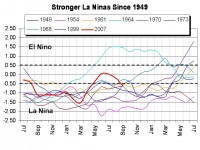
See larger image here.
In a paper in 1997, Mantua et al found the “Pacific Decadal Oscillation” (PDO) is a long-lived El Nino-like pattern of Pacific climate variability. While the two climate oscillations have similar spatial climate fingerprints, they have very different behavior in time. Two main characteristics distinguish PDO from El Nino/Southern Oscillation (ENSO): first, 20th century PDO “events” persisted for 20-to-30 years, while typical ENSO events persisted for 6 to 18 months; second, the climatic fingerprints of the PDO are most visible in the North Pacific/North American sector, while secondary signatures exist in the tropics - the opposite is true for ENSO.
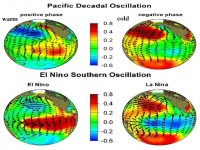
See larger image here.
A study by Gershunov and Barnett (1998) shows that the PDO has a modulating effect on the climate patterns resulting from ENSO. The climate signal of El Nino is likely to be stronger when the PDO is highly positive; conversely the climate signal of La Nina will be stronger when the PDO is highly negative. This does not mean that the PDO physically controls ENSO, but rather that the resulting climate patterns interact with each other. You can see the similarity of the El Nino to the positive PDO and La Nina to the negative PDO ocean temperature anomaly pool configurations above. Not surprisingly as the following shows, El Ninos as shown by the positive MEI spikes are more common during the warm phases (1977-1998) with La Nina (spikes down) more common in the cold phases as we found from 1947 to 1977 and after 1998.
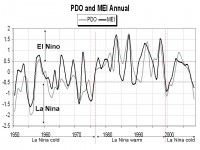
See larger image here.
The above shows how they follow in lock step with El Ninos and La Ninas augmenting the strength of the accompanying PDO state when they are synchronous and weakening it when they oppose each other. Since El Ninos lead to more global warmth than La Ninas, periods during which the PDO is positive and there are more and stronger El Ninos are not surprisingly periods of increasing global warmth (what we observed from 1979 to around 2000). Conversely cold PDO phases with more cool La Ninas lead to global cooling as we observed from the 1940s to 1970s and again after 1998.
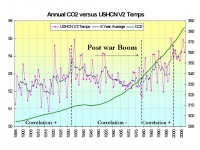
See larger image here.
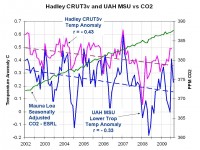
See larger image here.
See full story here.




